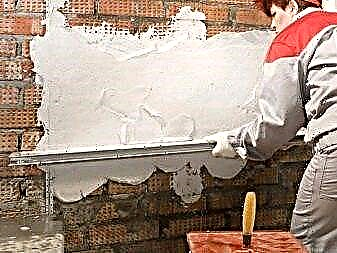Many people have suburban summer cottages where they can relax from the bustle of the city and put themselves in order. But rest should be comfortable and, first and foremost, safe. To achieve this result, you need to fence your area with a fence. And the best option in this situation is to install a fence with brick pillars.

The idea
Before starting such a large and grandiose project, you should familiarize yourself with all the proposals that companies for the construction of these structures can offer.
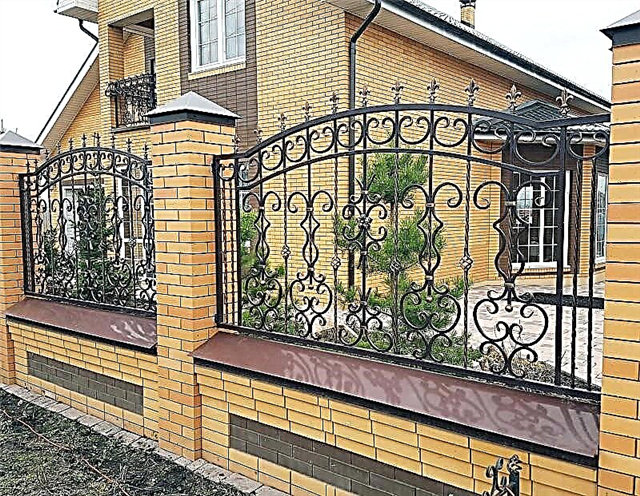
In order to find them, it is not necessary to go to each store and specify all the details. Using the World Wide Web, you can find information, and a photo of a brick fence, and any other information regarding this product.

The main thing is to correctly analyze the market and choose exactly the product that is most suitable.






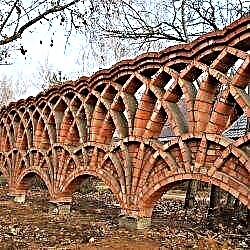
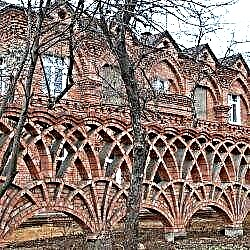
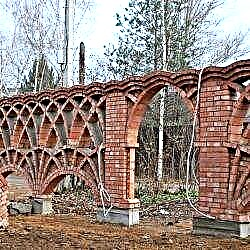
The foundation
Before starting the laying of a brick fence, a person needs to choose the material that will be used in the construction of this design. After all, it is safe to say that a fence is not only a way of protection. It can also be used as an element of external decor.

Thanks to a presentable appearance, he will be able to compose a whole design ensemble together with other objects in a summer cottage.

Therefore, for this, there are a large number of different types of bricks. Here is some of them:
Facing brick
Very popular material on the market. Due to its universal properties, it has the ability to add unique lines and original design solutions during the masonry process. This brick can take the form of any material, and also it does not need final processing. The color palette is huge and varied.

Chipped brick
Brick, the main purpose of which is decor. Quite an expensive model, so most often it can be found at the facilities of wealthy people. It has good strength characteristics. Due to its shape, it can give the fence an unusual look.

Silicate brick
Classic - silicate brick. An economically viable option, in terms of strength and power, not inferior to the richer “brothers”.
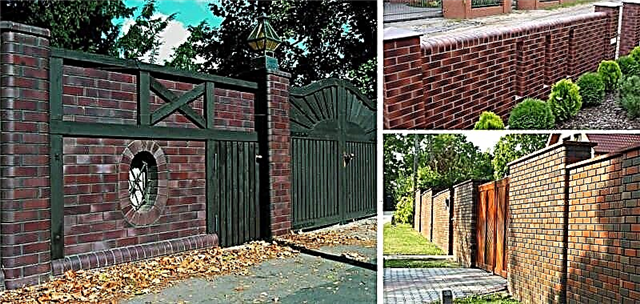
Of course, in appearance it does not reach expensive models, but if it is beautifully lined, you can get an effect that will not be inferior to fences from expensive estates in any way.
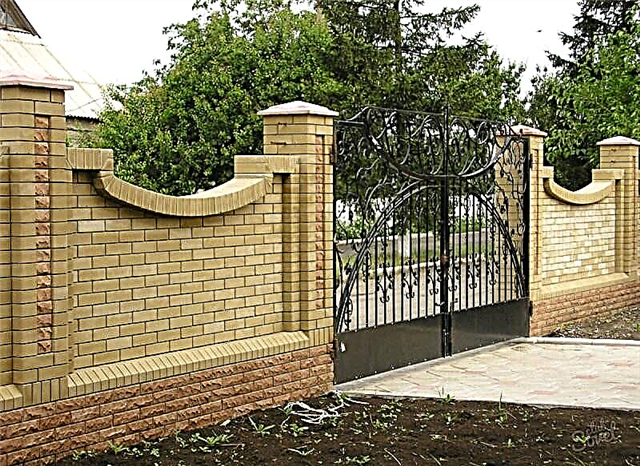
Advantages and disadvantages of a brick fence
The advantages of building brick fences made of stone include the following:

The brick fence is very strong, durable and looks solid
Massive construction.
There are not many disadvantages of brick fences, but they are also present, these are the following factors:
- Under the fence, it is necessary to build a strong foundation.
- A lot of work with the fence. Because of this, slowdown also occurs. After all, it is necessary to wait some time after each stage.
- A brick fence needs protection against moisture.
- The cost of this design is quite large. And the decor elements will further increase the price.
The basic principles of the construction of a brick fence
To learn how to build a brick fence, you need to prepare the following main parts:
- Pillars of a support which are located at a distance from each other.
- The walls between the supports.
All these elements are built on a strip foundation, but always with reinforcement.
Tool for work
To build a brick fence, you need tools, best professional. The following set is needed on a brick fence with your own hands:
- Construction mixer. It looks like a drill, which has a special nozzle for mixing the mixture.
- Ladle. A hemispherical container with a wooden handle, which is also used to level the mixture over the laying of the structure.
- Master OK. A blade made of steel, at the end of which there is a plug made of metal. Use this tool to remove excess masonry mixture.
- Level. The ruler, in the case of which there are water levels, which allows you to clearly align the masonry horizontally and vertically. And also used to measure an angle of 45 g.
- Plumb line. Cone with a rope. It is used to check the vertical.
- Pickaxe. The gun is like a hammer, but has a sharp point on one side. Used to give the bricks the desired shape.
- Ruler. It is needed to check the outside of the styling.
- Stitching. Applied to align the seams.
- Cord. It is necessary to align the horizontal. It is pulled on each row separately.
Fence Options
To make a brick fence, you need the following:
- A piece of land, about a hundred parts 6.
- Metal gate and gate.
- It is best to lay in 2 stones.
- The height is about two meters, but maybe more.
- Use a single stone for fencing, dimensions 65x120x250 mm.
- The thickness of the joints at the brick fence is standard for stone products - 10 mm.
- The trench for the foundation must be at least 0.7 m.
- The foundation for the brick fence should be approximately 100-120 cm.
- Support reinforcement required. Without it, the foundation will stand for a very short time.
Payment
To correctly calculate the cost of materials for a brick fence with your own hands, you can use 2 ways. The first one is simpler, use an online calculator. The second is to have an initial foundation of knowledge of mathematical calculations. For this, the following must also be considered:
- The total area of the entire fence.
- Amount of elements. And the consumption of materials for each of them.
- For simplicity, the calculation uses the following dependence. Masonry fence in 1 stone = 100 pcs. in consumption, in 2 bricks - 200.
DIY Brick Fence Technology
To build brick fences with their own hands, experts conditionally divide into the following construction and installation stages:
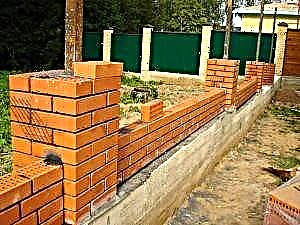
To make the masonry perfectly smooth, use horizontally stretched thread along the row
Selection of material. For a brick fence, you will need materials for the mortar: sand, water, cement, and certainly the stone itself. For fences, ordinary red brick is used, but at the finishing work it needs decoration. Facing stone is quite popular, because it does not need to be plastered, and it can be with an imitation of any surface. For strength and durability of the fence, fire-resistant brick is used.
Perimeter marking
To plan the site, use a tape measure, pegs, cord and markup is carried out the following plan:
- In places under the foundation around the perimeter, starting from the corners, drive in wooden posts and pull the cord tightly over them.
- Immediately take into account openings for gates or other inlets. And the same they are noted on the territory.
- It is better to double-check corners several times. They should be perfectly even.
- The bottoms are controlled by the theodolite. This is especially necessary in places where the base tape passes with the intersection in the corners.
- The span between the pillars of the support can be from 2.5 m to 5. Its duration depends on the expected height and structural features of the brick fence.
Foundation building
One of the main types of foundation for a brick fence is a strip. In rare cases, a monolithic type of base is also used, but it is quite troublesome to perform and requires special skills. Pouring such a foundation under a brick fence is necessary for 1 time. The tape base is erected as follows:

As a rule, the width of the trenches should be 40 centimeters. The depth of the trench is about 40-50 centimeters
Choosing the width and depth of the future foundation, you should pay attention to the dimensions of the fence such as laying and brick.
Construction of pillars and fence walls
Masonry from pillars for a fence with your own hands or a basement. The latter is mainly needed for the aesthetic appearance of the structure. The height of the base is erected more than 300 mm, this is about 4-5 rows of single brick. For pillars, it is better to use a laying of 1.5, and in some cases 2 stones. The entire number of sections is the construction of columns as follows:
- A metal core is placed on the basement in the basement; everything around them is covered with stone. After the masonry of the structure is completed, concrete is poured into the pillar and very often it is covered with an ordinary metal cap.
- The spans of the fence are erected on a base or base. Apply masonry with a thickness of one brick or 1.5.
- It should be borne in mind that the height of the spans should be less than at the column by about 10%.
Features of bricklaying
When laying a stone, you must adhere to the following rules:
- To control the evenness of each row, as well as the verticality of the seams.
- Residual solution should be removed immediately.
- After the end of the masonry, the seams are processed with the help of embroidery.
- During the construction of a half-brick wall, it is worth considering barriers, gates and other structural elements provided for by the plan.
- Bookmarks for doors or openings for cables are placed on necessary surfaces.
- When the fence is ready, it should be treated with special means for stone.
Possible problems and solutions
One of the main problems that arise when building a brick fence with your own hands is the construction of pillars. When constructing them, the following troubles arise:
- The upper part is wider. This defect appears due to poor order control. This strangeness can also occur due to the different thickness of the seams. So with a deviation on each row, at least 1 mm, by the end of the column you can already see as much as 2 cm. This problem cannot be fixed, it can only be avoided. To do this, use a tape measure or in general a template made of a flat bar.
- The corners of the pillars have movement. If there is a mixture of angular borders, then visually such a pillar will be twisted, and to fix something on it will be very problematic. Avoid such a defect, when during masonry use the erection of simultaneously 2 angles at once, which are attached to the bottom.
Problems arising during the construction of a brick fence are quite rare. These include defects such as:
- Shrinkage of the structure. This is due to the large weight of the building and the inadequate foundation. Or the base was not reinforcement.
- Shrinkage of the foundation occurs due to a violation of the rules for concreting the base. When they begin to erect the structure itself, without waiting for the cement strength. That is, earlier than 7 days. And in some cases more should pass. It all depends on the temperature and climatic conditions.
- The destruction of the masonry. The fence begins to fall apart, sometimes even with construction in progress.
This problem occurs due to improperly created masonry mortar. The proportions of part of the cement in the composition of concrete plastic norms may be violated, or poor-quality materials or be stored improperly.
It is necessary to store building materials in a dry place that does not have a sharp temperature drop and high humidity.
If you don’t know how to make a brick fence, then building a high-quality brick fence will not be difficult if you adhere to the rules of construction and pay attention to all even the smallest details.
Types of Brick Fences
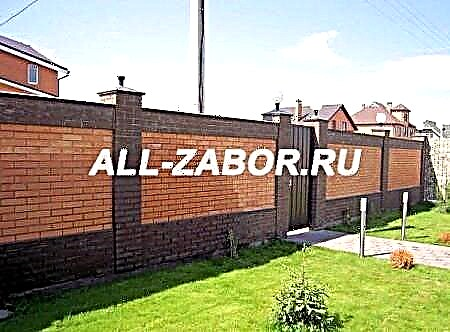
Price: from 4 600 rub. / sq. m

Price: from 3 700 rub. / sq. m
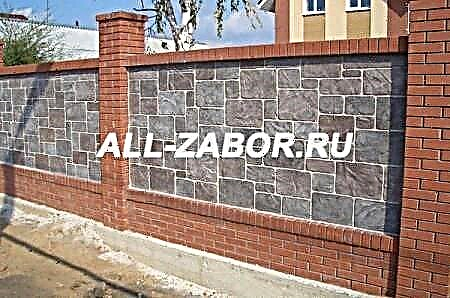
Price: from 4 450 rub. / sq. m
Price: from 0 rub. / sq. m
Price: from 0 rub. / sq. m
Price: from 0 rub. / sq. m

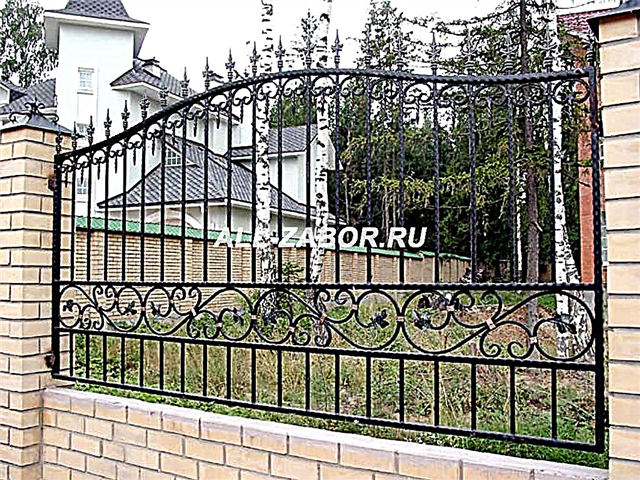

Brick Fence Prices
| Brick fences | ||
|---|---|---|
| Name | Height | The cost of p / m. from 30 p./m. |
| Solid | h-1,8 | from 7300 rub. |
| h-2.0 | from 7900 rub. | |
| h-2,2 | from 8600 rub. | |
| For a private house | h-1,8 | from 5600 rub. |
| h-2.0 | from 5900 rub. | |
| h-2,2 | from 6100 rub. | |
| With a stone | h-1,8 | from 6820 rub. |
| h-2.0 | from 7100 rub. | |
| h-2,2 | from 7250 rub. | |
| With corrugated board | h-1,8 | from 5600 rub. |
| h-2.0 | from 5850 rub. | |
| h-2,2 | from 6100 rub. | |
| With tree | h-1,8 | from 6050 rub. |
| h-2.0 | from 6340 rub. | |
| h-2,2 | from 6950 rub. | |
| With forging | h-1,8 | from 6950 rub. |
| h-2.0 | from 7150 rub. | |
| h-2,2 | from 7300 rub. |
Prices depend on several factors. This is the quality of the selected material, and the structure of the fence itself and the complexity of the design. For example, you can erect a fence with pillars of brick, and between them to place the canvas of wood or forged metal. You can also create a part of the fence from a brick a meter high, for example, and place a wooden or metal part above. There are many possible options. The quantity of spent material also plays a role (masonry with a thickness of 1/2 to 2 bricks is possible, depending on this, the material consumption changes). Also, do not forget that any such fence requires a foundation!
Make a preliminary calculation
Call the wizard for measurement
You can call
and we will call you back
Benefits of installing a brick fence
- beauty - the excellent appearance of this fence emphasizes the social status of its owner,
- Strength and reliability - Consciously built fence will stand for more than one decade. At the same time, it provides an excellent level of protection, both from prying eyes, noise and dust, and from attempts to penetrate your site,
- Wear resistance - such a fence does not change its appearance over the years,
- The ability to choose any structure, shape and color - at the request of the customer, it is possible to finish the fence with artificial stone.
Brick brick
Expensive, but at the same time one of the most trending materials in our time. Most often attract people with their appearance and great opportunities for installation. Clinker brick is made using special clay and is not inferior in strength to other types.

Due to the lack of internal voids, it can last for decades, but due to the complexity of manufacturing it is quite expensive.

Hyper pressed brick
Well, a completely new trend is a protective structure made of hyper-pressed brick. The main differences are resistant to environmental changes, durable, environmentally friendly. Made material in various colors.

Pros of brick
Before you fill the foundation under a brick fence, you need to understand if it has advantages! Or it may be worth the time and weigh your decision more carefully. But if a person has already decided to erect this particular structure, then he will not fail with his choice.






A brick fence has a number of important advantages that distinguish it from other analogues. These include:


Reliability. A fence made of such material will serve as an excellent protection against “casual” guests and the eyes of curious neighbors.

Long service life (minimum 10 years). With proper use, such a fence will stand for a long time and will serve not only those who built it, but also their children.

Thanks to the masonry, this design can easily withstand any natural disaster (of course, within natural limits) and there will be no envy from changes in the temperature environment.

Attractive look. The fence can be built not only for protection, but also for the decoration of the square, because on it you can realize a large number of different ideas. For example, add small arched arches or weighty columns to the structure.

If we consider a brick fence as an investment, then this is the most reasonable move that a person can perform.
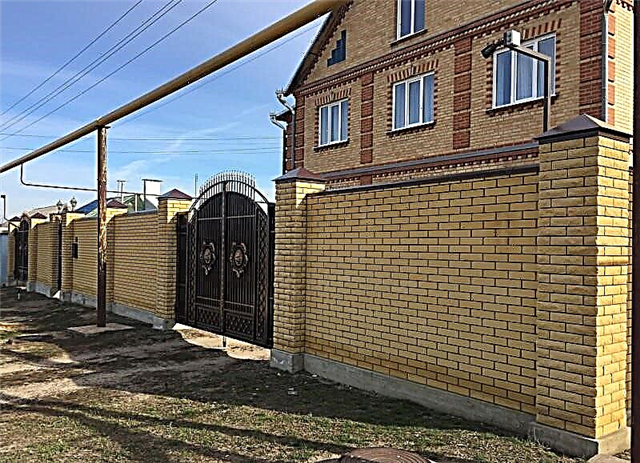


DIY fence installation
If a person has a number of specific skills, then he can easily make a brick fence with his own hands. To do this, he will need patience and an auxiliary construction tool:
- trough for solution preparation
- shovel for mixing
- hammer,
- Bulgarian,
- rope,
- cement,
- fittings,
- sand,
- putty knife,
- gravel
- water,
- buckets.

DIY installation of the fence can be divided into several stages:
- stage one - the collection of construction tools,
- stage two - the choice of material,
- stage three - viewing recommendations related to general design,
- stage four - marking the site,
- this fifth is pouring the foundation,
- stage six - brick laying,
- Seventh stage - the final cleaning of defects.

Main advantages
The decorative compatibility of even an unpretentiously designed fence will perfectly decorate all the varieties of houses known today, based on a frame base, wooden details, metal and glass structures.

Design ideas for decorating a brick fence amaze people with its quantity and economical consumption of money. To build a chic fence, the owner must work properly with materials and have a rich imagination.
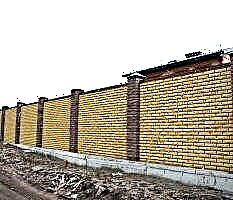






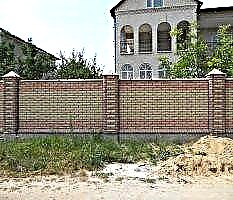

Protection of the site from potential threats. High-strength fencing will protect the private territory from unauthorized penetration of intruders. It will effectively prevent the accidental entry of a vehicle driven by a drunk driver, the ingress of bulky construction equipment and will hide the landscape from prying eyes.

You should be aware that due to the specific nature of the brick, the occurrence of errors is almost impossible to fix. Choosing the dimensions and shape of the wall, you need to think through a lot of the most important nuances and ensure the most exact adherence to technological instructions when performing laying work.

The main disadvantage, due to which the brick fence with its own hands is underestimated, is the high price of consumables, as well as too high a level of complexity of construction.

But today there are ways thanks to which the cost of a brick fence is rapidly decreasing. It allows you to create a full-fledged structure, using the thickness of the rows in half or one quarter of the block.
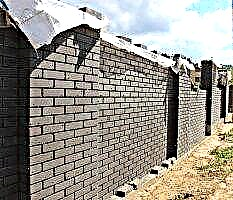








Construction stages
All the work that professional builders carry out during the preparatory processes and assembly of the structure are divided into four stages:
- In a specialized company or on the corresponding Internet resource, the style of the fence design is selected.
- The estimate documentation is carefully formed, where the cost of consumables and services of qualified craftsmen is calculated, after which the construction of the wall is designed.
- A trench is dug to a certain depth, where a sufficiently reliable foundation is built for a brick fence.
- The blocks that make up the main structure of the supporting pillars and enclosing walls are laid on its design.

The correct installation of decorative elements, trellised products, protective parts, lighting devices. The surface is treated with substances that slow down the loss of a characteristic shade and the destruction of burnt clay.

Then, the previously created surface is treated with a paint and varnish substance that is in harmony with the palette of all landscape components.




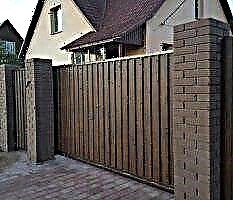
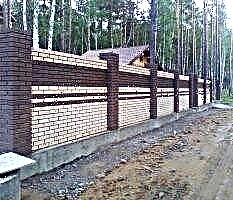



Foundation construction
The fence, built of natural or artificial stone blocks, has a high weight. Therefore, builders form the foundation according to the technological rules for obtaining buildings from brick.

If geologists have discovered stone soil, it is possible to equip a shallow base of the tape type. On the other rocks, durable supporting piles are erected, where a concrete tape is attached. The construction technology of a similar kind of foundation requires digging a trench 40-50 centimeters deep.

Depressions are made in the ditch, the underground level of which reaches 120-150 centimeters, and the bottom is equipped with gravel stones and a sand layer. Then a reliable waterproofing is created from a roofing sheet 120 cm long, and reinforcement is installed, previously welded from hot-rolled rods. Its height should ensure compliance of a similar parameter of the rods located in the well with the level of the planned fence posts.

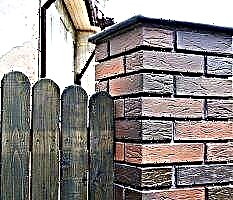
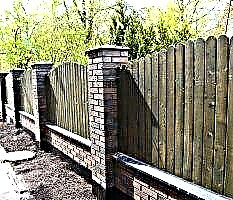
The plane of the concrete surface rises through the installation of formwork boards with a height of 20-30 centimeters. The foundation filled with concrete is treated with a protective film and left alone for seven days, necessary for setting the fixing mixture.

When the low strength of the soil is unable to fully withstand the fence with brick pillars, the reinforcing structure can be replaced with a square pipe with walls from 60 to 80 millimeters thick.
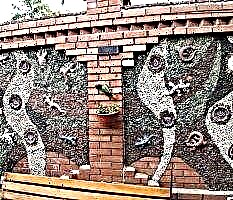





Brick laying
A reliable stone fence is being erected using the technology of forming the walls of a residential building. Here, corner posts are built, intermediate supports are made from a height of half to 0.7 meters and the walls are equipped.

Specialists lay out half-meter designs from rows in half of the building block. The columns of the two-meter fence consist of two-row masonry, and the thickness of the wall corresponds to one stone. Blocks of constructed columns are tied with a special wire with wall elements.

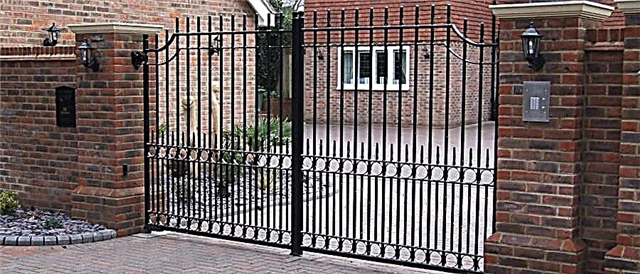
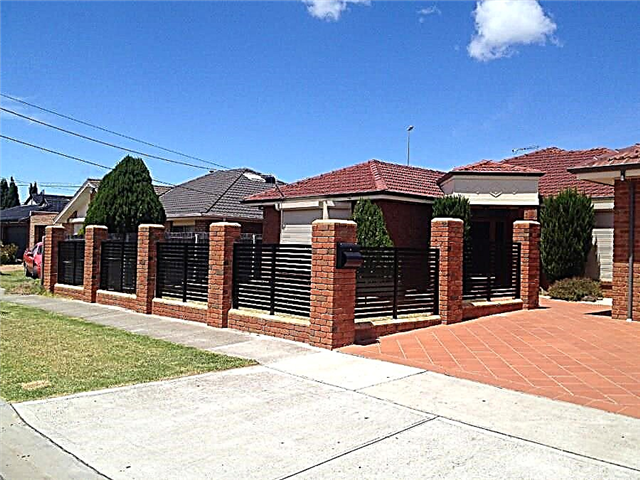
Builders pull a fishing line every 4-5 steps to detect surface defects. Before the mortar is completely solidified, errors can be easily corrected by tapping the hammer with a rubber tip on a wooden rail.

To obtain the optimal thickness parameter for the joints of the front side, you must use special polyvinyl chloride frames. They equip the gaps between the main elements of the created series.

After the cement has set, the bookmarks are eliminated, the vacant space is covered with multi-colored mixtures. When performing work, the correct geometric shape of the row is observed, excess leaked solution is removed, the front surface is thoroughly cleaned of adhering drops.





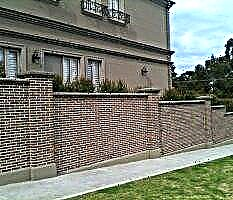



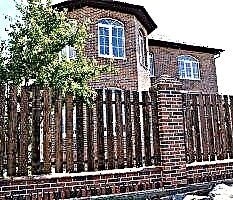


Pattern selection and finish
A pre-built brick fence with corrugated board is quite easy to decorate. But until recently, the decoration of columns and piers of more solid objects took a lot of labor and financial resources.
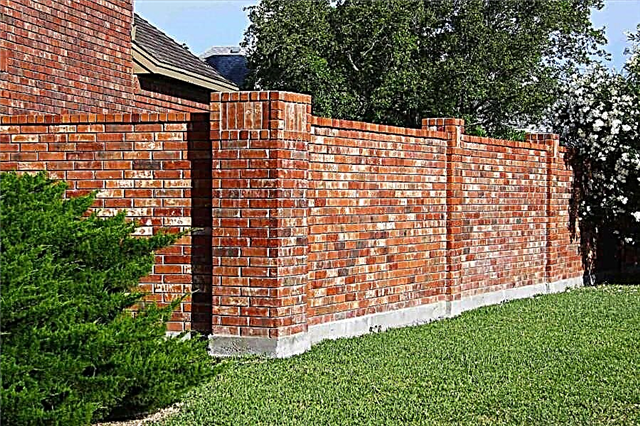
The development of the construction industry allowed decorating the structure with gratings, vertical steel bars or iron patterned plates. The classic spoon bandaging of blocks is perfectly replaced by other methods that experienced designers came up with.
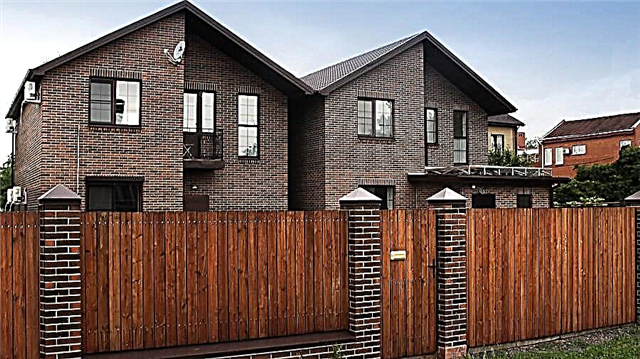
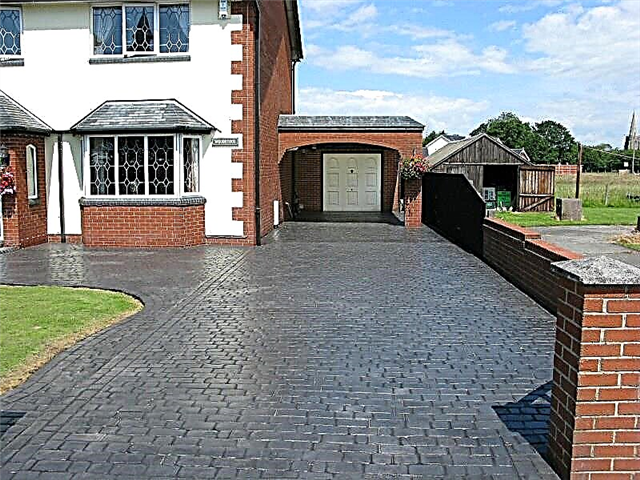

The red walls of the fence harmoniously combine with decorative varieties of plants. The correct use of rectangular openings saves 60 percent of the area by decorating a reliable open fence.



Slag stones or rubble stones increase the amount of savings, as well as reduce the consumption of cladding parts to 20 percent of their total number involved in the construction of a two-meter wall. The use of bricks with a dark color allows you to cover the joints with white cement.

On some photos of the brick fence, owners may notice the presence of special protective caps. They prevent atmospheric precipitation from entering the top of the pillars and the wall. The choice of pre-ordered overhead patterns and decorative trims is determined by the general appearance of country objects.

Correct installation of fake lights at the top of the support columns will form the status appearance of the fence. The base is covered with stucco mixtures, or tiles imitating granite or basalt surface.
Features
The key advantages of brick fences in comparison with others can be considered:
- excellent durability
- attractive appearance
- the possibility of combining with houses and plots decorated in any style.

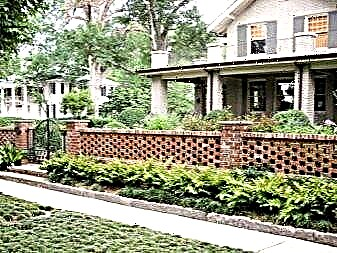
The use of facing bricks is recommended when creating decorative masonry. This material is completely finished, not requiring additional processing, the variety of its color and texture allows you to realize the most sophisticated design idea.
If you wish, you can complement the brick fence with stone, wood, stylish art forging. The latter option is advisable if you want to create an environment that is outwardly interesting and not too catchy.

A universal fence made of bricks can be easily redone if necessary: if necessary, you can quickly increase its height, lower it, and the design will look just as attractive. Both from the outside and from the side of a private house from the yard, the appearance will be exactly the same. Depending on the wishes of customers, it is possible to arrange the fence additionally, masonry is plastered or covered with panels corresponding to the design of the home.
However, a brick that has not undergone additional decoration looks very good.

Types of masonry
Technologists and builders have developed various types of bricklaying, one of the most modern and attractive options is considered lego system. Compared to using the classic type of blocks, the speed of operation increases significantly, and special training is minimized. Simply apply the top row to the bottom in an intuitive way, after which they are glued with construction glue. Lego bricks are hollow inside, which greatly facilitates their transportation and movement directly to construction, reduces the complexity of the work.
The use of hyper-pressed material is advisable when even the protection provided by the classic type of masonry is not enough for you. This is a very durable and stable product, and it is critical for the manufacturer to follow the technology. If it is broken, then cracks and defects will inevitably appear even with the most accurate work, and the service life of the fence will be drastically reduced. As for increased thermal conductivity, this indicator does not have any significant significance in the construction of fences.
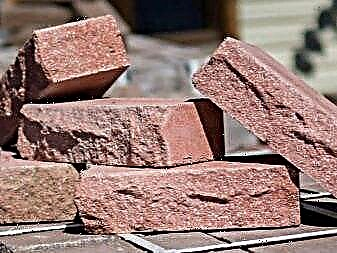

Bavarian masonry brick opens up a number of important possibilities, strictly speaking, this is not so much a special method as a specific material. You can see it in any old building, and not only on German territory, but also in all other European states. The essential feature of the Bavarian approach is that the external side of the material is painted in a variety of colors, forms unusually attractive patterns. Over the centuries, no efforts of the masters allowed to create a good monotonous coloring of bricks. And so the disadvantage began to be turned into dignity.


What was considered a problem in the past today has completely turned into a characteristic feature of country style or Provence, a way to emphasize the elegance of the old look of the fence.


Bavarian brick is made according to a specific technology, at the end of its firing, the oxygen concentration in the furnace is increased so that the clay composition changes due to chemical reactions. Therefore, the outer layer is colored differently. The vitreous mass in thickness takes a minimum of 0.2 and a maximum of 0.4 cm. The brick obtained by the South German method, even in the most unfavorable combination of circumstances, will not be covered with efflorescence.


The width of the blocks is completely standard, but its appearance has stepped forward far in recent years. The engineers managed to figure out how to make the shape of the stains very intricate, combining these findings with the creation of smooth or texture surfaces.


Experts do not recommend using more than four shades for one part of the fence - this will only complicate the work and the selection of the necessary components.

Important: the key color covers at least ½ of the entire area, and the remaining two or three tones are randomly selected as you see fit.
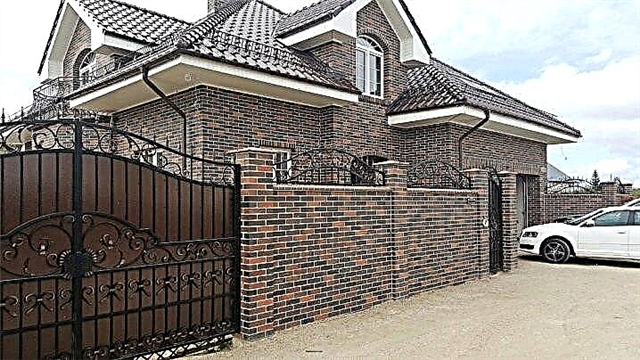
Decor
Brick in combination with forging is perceived very elegantly, you can use it either as decorating parts, or as a functional part of the design. You can vary the configuration and size of the forged blocks, arrange them in an original way.


In the parapet pattern, forged rods and other decorating elements are placed on an inextricable layer of brick.
Important: their height above the top edge of the fence should not exceed 50 cm. Such a solution is externally attractive and, in addition, reliably stops most unprepared attackers.
If a plinth (0.3-1.5 m) is placed over the main part of the bricks, very various forged blocks are also mounted on top of it. A characteristic feature of this approach is that the fence is transparent.
You can choose the third method, in which brick pillars are combined with forged structures. Forging in this embodiment accounts for the bulk of the length, and bricks can only be seen in pillars or columns. And even the pillars themselves, columns inside can have reinforcement, which increases their mechanical resistance.
Brickwork can be supplemented not only by a figured forged element, but also by wood, note that her presence does not always mean an opportunity to save. Most often, such a step is taken, wanting to use a tree that is not needed for other purposes and at the same time create a spectacular, concise architectural ensemble.

However, even if you restrict yourself to just one brick, you can also achieve a very interesting result. Color solutions are quite diverse, and many beginner experimenters are confused by such a huge selection. Often they try to reproduce the type of facade coating in the house, for example, using shades of red with orange inclusions. Experiments with a brick of brown, yellow, white colors are also widespread.
Wine tonality (Marsala) is perceived very attractively, It is especially good to use such fences as accent elements. It makes sense to use a gray palette in areas decorated in a modern or urban style, such a coloring perfectly combines with abundant use of concrete.
Choosing a combination in a country house, in a summer residence, focus on the color scheme of the garden path and grounds, in which case it will be possible to use not just a different color, but also a completely different material to decorate the facade of the house.

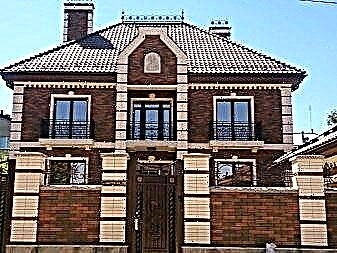
Of ordinary and clinker bricks, you can build a "perforated" fence, being built in a checkerboard pattern. Through the gaps, you can observe the courtyard and the street, the strength of the structure is somewhat reduced, but this is not so significant.

In addition to these options, you can decorate the fence with ordinary plants, imitations, stained glass and ceramics.
Returning to the topic of clinker, it is worth emphasizing that it not only looks very elegant, but also absorbs water very little, does not crumble for as long as possible. The fence from it will last a long time, and the block can be very diverse in appearance - corrugated, rough, completely smooth. Clinker fencing looks optimal both in ultramodern villas and in imitations of old estates, even the simultaneous laying of the walls of a house from it is permissible.
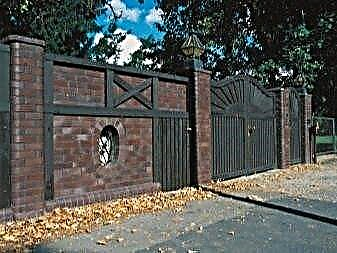
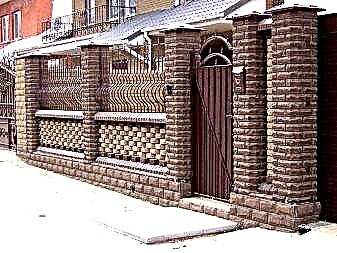
Using chipped bricks, you can achieve impressive results, the torn block surface is difficult to distinguish from natural stone. It is so nice to imagine yourself as residents of a medieval knight's castle!
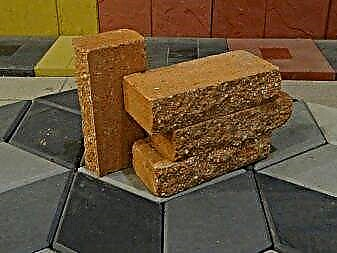

Silicate brick allows you to completely abandon the special decor; for facade installation, it comes mainly in white. A combination of white pillars with a red or brown-brown array or vice versa looks nice.

Facade timber (aka decorative timber or plank) is a subspecies of facing bricks, despite the increased price, it is quite reasonable to use it, there will be no risk of destruction of the supports and the entire structure as a whole.
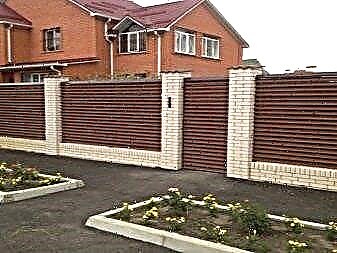

Concludes our review of the type of fences, called "bassoon" (literal translation from Italian - an armful of firewood). Appearance reproduces the atmosphere of natural stone, but sometimes the surface is a little chipped. The weight of one block can reach 4 kg, products with chips about 200 g lighter, and the combination of such options among themselves is very nice.
Material combination
Combined fences always look more elegant than those made from only one type of material. It is not difficult to increase the sophistication of the fence - you just need to supplement the brick with art forging.


If you use a metal picket fence, you can save not so little money. At the same time, such constructions serve for a very long time, they are able to limit outside observation of what is happening on the site, but at the same time, the view does not completely overlap. You can always choose an option that imitates a brick or harmoniously combined with the appearance of the home.

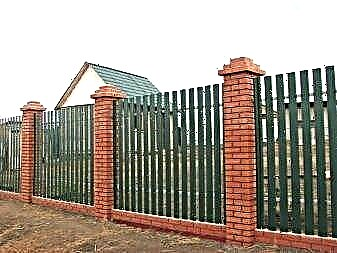
An advantage of a picket fence made of metal is a high level of safety - such constructions cannot be scratched even specially.

But those who prefer to supplement the fences with a wooden type of blocks, including with the help of lining, have their own strong arguments. Taking a natural tree, you can significantly improve the soundproofing quality of the fence. And it will be more effective to stop a strong wind than a brick wall.
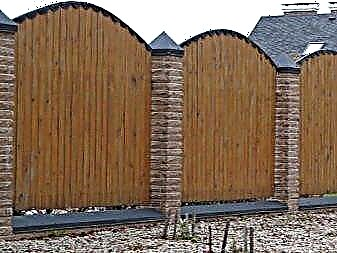

It should be noted that a wooden canvas, no matter how light it may seem in itself, increases the mass of the fence. Therefore, it will be necessary to equip all the places where such elements are used with a more powerful foundation. In the case of massive steel parts, the situation is similar.

Beautiful examples
It is often thought that a brick fence is always a tall and solid structure that looks indestructible from the outside. However, there are completely different options that look very original. For example, a very low fence with pillars raised in several places. However, even with the traditional height of the barrier, its appearance is unique. Here, the builders were clearly inspired by the idea of combining moderately red and whitened sections of the wall. They ended up with a great looking fence that captivated enthusiastic looks.

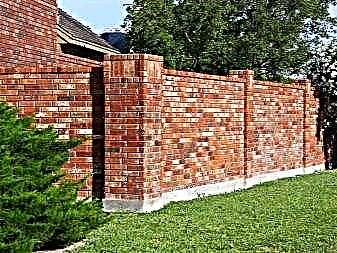
Another attractive solution is to use expressive dark accents, harmonizing in tone with the upper bar, placed above all the brick rows. It is important here not to introduce too many dark elements, otherwise it will look gloomy.

Some designers believe that individual bricks do not have to be straight. Using decorative products of complex geometric shapes, you can create a delightful ornament. Its attractiveness will only increase with the competent selection of color contrasts with the surrounding details.
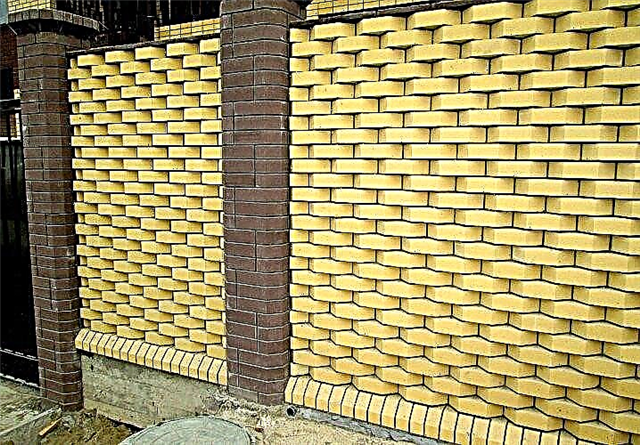
Our advantages

Thanks to our own production, we offer low prices.

Thanks to the many years of experience of our craftsmen, the installed fences always meet the highest quality.

We provide 2 years warranty for all our products.

No delays. Orders are executed strictly at the agreed time.
How is the measurement and installation
Brick fences - are a fairly solid construction, so their installation is a matter requiring certain professional skills. But before starting construction, it is necessary to determine the place and line of the future fence. You can try to measure the land yourself. For this you will need:
We drive in the pegs at the corners of the plot, we pull the rope between them, measure the resulting line with a tape measure, do not forget to take into account the footage of the gate and gates. Of course, without special equipment it is difficult to absolutely accurately measure the length of the fence, so it’s better not to experiment, but immediately turn to professional measurers who, taking into account all the nuances of the site and the angle of the fence, will make the necessary measurements.







